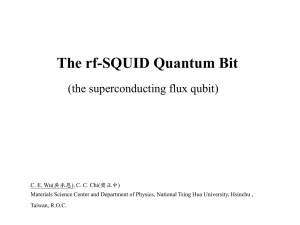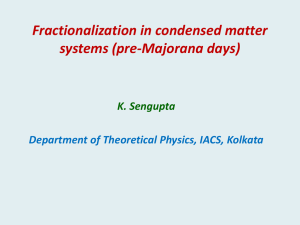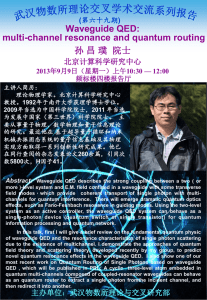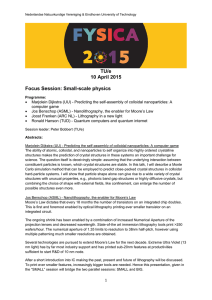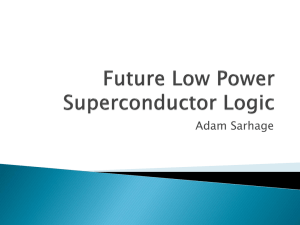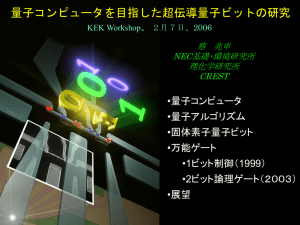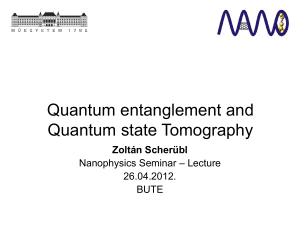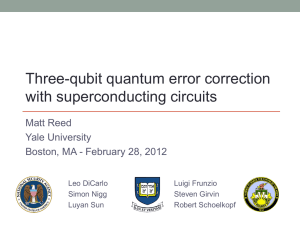Coherent quantum phase-slip in superconducting nano
advertisement
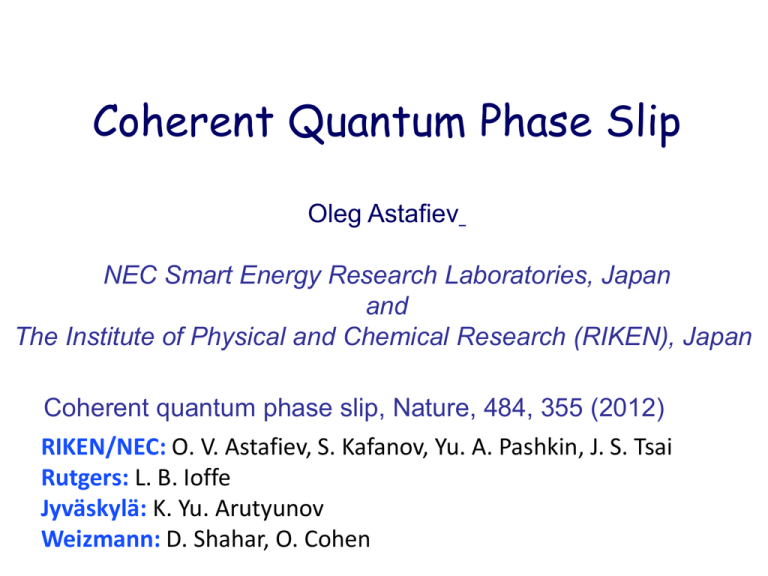
Coherent Quantum Phase Slip Oleg Astafiev NEC Smart Energy Research Laboratories, Japan and The Institute of Physical and Chemical Research (RIKEN), Japan Coherent quantum phase slip, Nature, 484, 355 (2012) RIKEN/NEC: O. V. Astafiev, S. Kafanov, Yu. A. Pashkin, J. S. Tsai Rutgers: L. B. Ioffe Jyväskylä: K. Yu. Arutyunov Weizmann: D. Shahar, O. Cohen Outline Introduction. Phase slip (PS) and coherent quantum phase slip (CQPS) Duality between CQPS and the Josephson Effect CQPS qubits Superconductor-insulator transition (SIT) materials Experimental demonstration of CQPS Coherent Quantum Phase Slips (CQPS) Very fundamental phenomenon of superconductivity (as fundamental as the Josephson Effect) Exactly dual to the Josephson Effect • Flux interference (SQUID) Charge interference • Charge tunneling Flux tunneling Applications Quantum information • Qubits without Josephson junctions Metrology • Current standards (dual to voltage standards) What is phase slip? Cooper pair tunneling Space Flux tunneling Superconductor F0 2e Superconductor Space Superconductor Insulating Barrier Space Space Superconductor Superconducting Wire Josephson Effect: tunneling of Cooper pairs CQPS: tunneling of vortexes (phase slips) Thermally activated phase slips Superconductivity does not exist in 1D-wires: Width coherence length Phase-slips at T close to Tc are known for long time V Phase can randomly jump by 2 h V PS 2e t 2e I V R I Thermally activated and Quantum phase slip Thermally activated phase slips Are phase slips possible at T = 0? V Signature of QPS? Quantum phase slip T kT At T = 0: Phase slips due to quantum fluctuations(?) Quantum Phase Slip (QPS) Coherent QPS Incoherent quantum process coherent quantum process incoh < Spontaneous emission: Open space infinite number of modes Dissipative transport measurements: P = IV I Coherent coupling to a single mode: Resonator, two-level system single mode Nanowire in a closed superconducting loop Duality between CQPS and the Josephson Effect Mooij, Nazarov. Nature Physics 2, 169-172 (2006) Josephson junction EJ EJ 0 cos 2 Phase-slip junction 2F F0 1 2 2 ES ~ ES 0 2 Ck 2e q 2 1 2 E J ~ EJ 0 2 LJ F 0 2 ZY ES ES 0 cos q 2q 2e LC F0 2e The CQPS is completely dual to the Josephson effect Exact duality Mooij, Nazarov. Nature Physics 2, 169-172 (2006) f = Phase across junction Josephson Current: Ic sinf Kinetic Inductance: F0(2Ic cosf)-1 Shapiro Step: DV = nF0 [nq,f] = -i nq = normalized charge along the wire CQPS Voltage: Vc sin(2nq) Kinetic Capacitance: 2e(2 Vc cos(2nq))-1 Shapiro Step: DI = n2e Shapiro Step Shapiro Step IC VC Supercurrent CQPS voltage A loop with a nano-wire (PS qubit proposed by Mooij J. E. and Harmans C.J.P.M) Fext BS Flux is quantized: NF0 Hamiltonian: EN 2 NF 0 F ext 2L ES N N 1 N 1 N H EN N N 2 The loop with phase-slip wire is dual to the charge qubit The Phase-Slip Qubit F ext NF 0 2 EN 2L Degeneracy E 0 1 2 3 Magnrtic energy: EL >> kT Fext 1 0 0 1 Phase-slip energy: ECQPS CQPS qubit: 4 EL >> ECQPS Duality to the charge qubit LC F0 2e Fextqext Cg C Cg Box EJ Vg qext Vg Cg Reservoir Charge is quantized: 2eN Hamiltonian: EN 2 2eN qext 2C EN EJ N N 1 N 1 N H N N 2 2 The loop with phase-slip wire is dual to the charge qubit Choice of materials Loops of usual (BCS) superconductors (Al, Ti) did not show qubit behavior BCS superconductors become normal metals, when superconductivity is suppressed Special class of superconductors turn to insulators, when superconductivity is suppressed Superconductor-insulator transition (SIT) High resistive films in normal state high kinetic inductance RQ ES D exp a R Superconductor-insulator transition (SIT) 107 Requirements: high sheet resistance > 1 k Sheet resistance R□ () 106 InOx, TiN, NbN 105 High resistance high kinetic inductance 104 Rn Lk D 103 102 101 0 5 10 T (K) 15 The materials demonstrating SIT transition are the most promising for CQPS The device NF0 Amorphous InOx film: R□ = 1.7 k (N+1)F0 E Es (N+1/2)F0 Fext MW in Gold ground-planes InOx 0.5 mm InOx Step-impedance resonator: High kinetic inductance 40 nm 5 m MW out Measurement circuit input output 4.2 K 1K Isolator -20 dB 40 mK -20 dB Isolator resonator Phase-slip qubit Coil Low pass filters Network Analyzer Transmission through the step-impedance resonator Z0 Z0 Z1 Current field the resonator 2nd Z1 >> Z0 1st Current amplitudes: maximal for even zero for odd modes Transmission at 4th peak 5 250 MHz 1.0 0.2 0.9 0.1 t t (a.u.) 1.0 4 3 0.5 0.8 0.0 6 0.7 7 8 9 f (GHz) 10 11 12 0.0 -0.10 -0.05 0.00 Bext (mT) 0.05 0.10 arg(t) DB Two-tone spectroscopy We measure transmission through the resonator at fixed frequency fres Another frequency fprobe is swept -5 arg (t) (mrad) 0 arg(t) (mrad) 0 Df = 260 MHz -2 -4 -6 5.0 The fitting curve: Ip = 24 nA, ES/h = 4.9 GHz 5.5 f (GHz) 6.0 Current driven loop with CQPS cosat Ip |1 a M |0 I0 ES H z x MI p I 0 x cos a t 2 2 a H z x cos a t 2 2 RWA: H int z 2 a 2 Es2 ES MI p I 0 a Transitions can happen only when ES 0 ES The result is well reproducible Three identical samples show similar behavior with energies 4.9, 5.8 and 9.5 GHz After “annealing” at room temperature InOx becomes more superconducting. The samples were loaded three times with intervals about 1 months. Es is decreased with time. Wide range spectroscopy 80 2 fprobe + fres (3-photons) DE/h (GHz) 60 40 fprobe + fres (2 photons) 20 D E / h 2 I d F E 2 0 p 2 s fprobe h 0.0 0.5 1.0 Fext/F0 Linear inductance! Decoherence Df = 260 MHz 0 arg (t) (mrad) Gaussian peak low frequency noise -2 -4 -6 5.0 5.5 6.0 f (GHz) 2qk ES ESk exp i 2e k Potential fluctuations along the chain of Josephson junctions leads to fluctuations of energy and decoherence Total PS energy: Potential equilibration (screening) in the wire? Mechanism of decoherence? NbN thin films R 2 k In MW measurements Tc 5 K L 1.6 nH/sq 20 different loops with wires of 20-50 nm width Many qubits can be identified General tendency: the higher resistance, the higher ES Transmission amplitude f (GHz) NbN qubits Conclusion We have experimentally demonstrated Coherent Quantum Phase Slip Phase-slip qubit has been realized in thin highly resistive films of InOx and NbN Mechanism of decoherence in nano-wires is an open question

